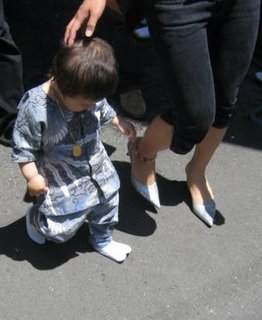
After arriving in Tokyo, John, Daisuke, Kazuko, and I went directly to the main thing we’d come to see: the annual Sanja festival. Sanjen means “three gods,” The festival is a Shinto celebration of three deities that seem to be the particular favorites of the residents of the Asakusa neighborhood, This area is the closest Tokyo, mostly a sprawling modern city, has to a gothic quarter. It too is full of the post-WWII tile and glass boxes you find everywhere, but somehow the area survived both the war as well as the great earthquake of 1923 better than the rest of the city. It wasn’t all built from scratch in the 1950s, and there are lots of traditional wooden buildings and a few grand temples that still exist.
The festival itself was a surreal affair. It was easily the most flamboyant and fun religious festival I’ve ever attended. The Sanja Masuri neighborhood residents parade around dozens of gilded portable shrines. Each one weighs about a ton. It’s carried by men and women dressed in period costume, this period being the Edo period, from the early 1600s to the mid-1800s. For women that means a robe and leggings, and children wear cute smock-like garments and headbands. (“Everyone looks like a sushi chef today,” said Daisuke.) Grown men, however, wear a short robe and not much else—just a sumo wrestler-style undergarment. It takes some getting used to to see these guys, who on any other day wouldn’t dream of wearing shorts in public, not even wearing pants.
Groups of people dressed like this carry around the shrines, parading them through the neighborhood, They are quite boisterous when they do this, chanting in an exaggerated manner and keeping the shrine moving not just forward, but in a rolling up-and-down motion, too, like it’s a groom at a Jewish wedding. I later found out that back in the day, Asakusa used to be Tokyo’s theater district, so the showmanship makes sense.
After the parade, Daisuke and Kazuko headed home, and John and I grabbed our luggage out of the locker we’d stored it in and went to our hotel. Called the Homeikan, it’s about 100 years old, and started life as a boarding house for nearby Tokyo University. It’s a traditional Ryokan style building, with heavy wood, tatami floors, futon mattresses, and a bathroom down the hall.
It was here that I got my first real taste of the intensive Japanese slipper experience: When you check into the hotel, you leave your shoes on a shelf in the lobby and put on one of dozens of pairs of waiting slippers. You wear these to the door of your room, but not a step farther. When you enter the room, you leave your hallway slippers outside and pad around your room in your socks.
If you should want to use the bathroom, you put your hallway slippers back on and walk to the lav. But there you have to abandon your hallway slippers and step into a pair of bathroom slippers, waiting for you just inside the bathroom door. When you’re done, and this is crucial, you step out of the bathroom slippers and back into hallway slippers, At your room of course, you have to remember to take your slippers off before you enter. I’m glad the hotel is sparsely booked today, because I’m having a lot of trouble with this. I understand the system; it’s just that the slippers are so comfortable and natural that I’m having a hard time being mindful of my feet—I completely forget what I’m wearing the second they’re on. Which in a way is good because I don’t love the idea of wearing communal shoes, even with socks.
After dinner, I went by myself to the Shinjuku district. This is the neighborhood where the movie Lost in Translation took place, and it’s the neighborhood that looks most like I expected. When I got to Tokyo, I was surprised to see that most of it is low and drab. I expected it to be a 21st century maze of neon-lit skyscrapers, but in fact, that’s really only to be found in Shijuku, which is half Tokyo’s business center, and half an entertainment capital. It was a lot like I expected, with Times Square-like neon and thick crowds flowing in and out of video arcades and pachinko parlors. It was interesting, but the sight of so many people having so much fun when I was all alone and barely understood what was going on was a little alienating and put me in a little bit of a funk, so I went home pretty quickly and made a long trans-pacific phone call. Pipi couldn’t be showing up at a better time.



No comments:
Post a Comment